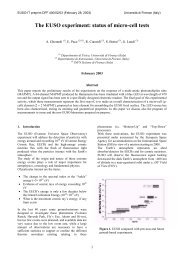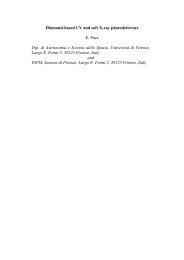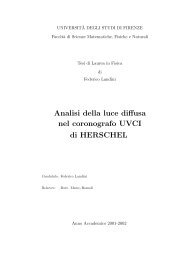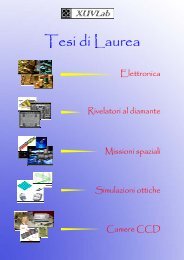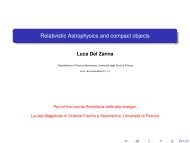2003 - Astronomia - Università degli Studi di Firenze
2003 - Astronomia - Università degli Studi di Firenze
2003 - Astronomia - Università degli Studi di Firenze
Create successful ePaper yourself
Turn your PDF publications into a flip-book with our unique Google optimized e-Paper software.
HERSCHEL optical design<br />
The HERSCHEL/UVCI (see HERSCHEL mission section pag. 03) optical design is now definitively frozen<br />
for both the optical paths (UV and visible light (VL)). This has been accomplished by means of ray<br />
tracing stu<strong>di</strong>es and optimizations of the <strong>di</strong>fferent optical components and of their mutual positions<br />
inside the whole instrument arrangement. The optical paths definition has been carried out with the Carlo<br />
Gavazzi Space team in order to taking into account the mechanical and optical requirements<br />
simultaneously. The ray tracing and the relative optical optimization have been implemented with the<br />
ZEMAX ray tracing program, then the optical design has been tested with a non-sequential optical<br />
software (OptiCAD) in order to study the stray light properties of the whole instrument assembly, with the<br />
mechanical supports included.<br />
The XUVLab has performed also the assembly tolerances analysis, which is a fundamental requirement to<br />
establish the optical components definitive positions and the range and resolution of the correspon<strong>di</strong>ng<br />
compensator tools.<br />
Finally, an alignment plan for the HERSCHEL/UVCI has been defined on the basis of the previous<br />
optical simulations and analyses, in order to specify the laboratory integration, alignment and<br />
verification procedures.<br />
Polarimetry (optical characterization)<br />
The XUVLab team has developed and construction a single reflection linear polarization analyzer,<br />
and selected, after laboratory tests, the best reflection plate material and incidence angle for the<br />
spectral region 90-125 nm [2,3]. The choice of this spectral window is related to the development of<br />
an UV polarimeter to exploit the linear polarization mo<strong>di</strong>fications induced by the Hanle effect to retrieve<br />
the magnetic field vector of the extended solar corona, in particular for the MIDEX/Advanced<br />
Spectroscopic and Coronagraphic Explorer (ASCE) NASA project.<br />
The material and the incidence angle selection has been performed in the XUVLab for several <strong>di</strong>fferent<br />
materials, selected in advance on the basis of the literature optical constants [4, 5].<br />
The comparison of <strong>di</strong>fferent material performances [1] can only be done on relative grounds, due to the<br />
lack of knowledge on the linear polarization degree of the incident ra<strong>di</strong>ation and on the material<br />
reflectivity of the analyzer plate. To overcome this problem a set of polarization measurements has been<br />
performed at the European Laboratory for Non Linear Spectroscopy (LENS), with a high-order harmonic<br />
laser beam. In fact, the laser ra<strong>di</strong>ation is fully linearly polarized allowing us to measure the absolute<br />
reflectivities, and therefore, to calibrate the XUVLab polarization analyzer. However, the data analysis has<br />
shown serious problems probably due to stray light contamination of the setup arrangement and/or to<br />
intercalibration failure between the two required detectors. New measurements are planned, with an<br />
improved setup, to overcome the encountered problems. These measurements include preliminary<br />
tests on a standard gold plate to check, with a real time data analysis, the consistency with literature<br />
values and then the reliability of the setup . Once the polarization analyzer is calibrated, it has several<br />
applications. It will be possible to measure the polarimetric characteristics of several devices such as<br />
gratings, mirrors, and other optical components in the vacuum UV spectral region.<br />
XUVLab activity summary <strong>2003</strong><br />
optical design and testing 11



